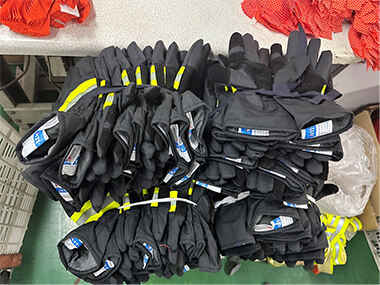Firefighter gloves are an integral part of every firefighter's equipment. They not only provide protection, but also ensure flexibility and comfort. Depending on the firefighting mission, the design and function of the gloves will also vary. This article will introduce several common types of firefighter gloves and how to choose the right gloves.
1. Structure and Design
The structural design of firefighter gloves usually includes the following aspects:
Outer layer: High temperature and fire resistant materials such as Kevlar, high temperature leather, metal fiber, etc. are used to prevent fire and heat damage.
Inner layer: To enhance comfort, the liner usually uses moisture wicking materials to prevent discomfort caused by long-term wear.
Waterproof: Some gloves are also designed with waterproof functions to ensure that firefighters stay dry when dealing with slippery environments.
2. Main types of firefighter gloves
Depending on the usage scenario and task requirements, firefighter gloves can be divided into several main types:
2.1 Structural protective gloves
These gloves are usually used to deal with high temperature and high pressure environments at the fire scene, and the design focuses on providing extreme protection. The outer material is made of high temperature and heat resistant fabric, which can effectively prevent flame burns. It has strong protection, but slightly less flexibility, and is suitable for long-term exposure to high temperature environments.
2.2 Rescue gloves
This type of gloves is mainly used for emergency rescue missions. The design emphasizes flexibility and agility, and is suitable for rapid response in high-risk situations. Although they provide certain protection, they are usually not as high temperature resistant as structural protective gloves. Therefore, they are more used for protection during rescue missions to avoid cuts and other physical injuries.
2.3 Water rescue gloves
For water rescue scenes, waterproofness and grip are key. The material is usually highly waterproof and designed with anti-slip texture to help firefighters operate stably in slippery environments. This type of gloves usually does not have the high temperature protection of structural protective gloves, but focuses more on coping with the challenges of water environments.
2.4 Pressure gloves
This type of gloves is mostly used to cope with high-pressure environments. The material design focuses more on protection and stability, and can effectively cope with situations of being pinched or high-pressure objects.
3. Considerations when choosing firefighter gloves
When choosing the right firefighter gloves, there are several key factors to consider:
3.1 Task requirements
Choose gloves based on the type of work you are doing. For example, when working at a fire scene, you need to choose protective gloves that are resistant to high temperatures; while when performing water rescue, waterproofness and grip are particularly important.
3.2 Dexterity and comfort
The comfort and dexterity of gloves are crucial, especially when you need to frequently operate tools or perform rescues. Make sure the design of the gloves provides enough room for movement so as not to restrict hand dexterity.
3.3 Protection level
The protective performance of gloves will vary depending on the material and design. When choosing, make sure the gloves can provide adequate protection, such as fire protection, cut protection, and chemical protection. The gloves we produce are EN659 certified and have very strong palm protection capabilities.
3.4 Size and fit
Different firefighters have different hand shapes and sizes. Choosing the right glove size can improve comfort and ensure better protection. The gloves should fit the hand tightly, but not too tight to affect movement.
3.5 Durability
Firefighter gloves need to withstand the test of harsh environments, so it is crucial to choose durable gloves. High-quality materials can not only extend the service life of the gloves, but also provide reliable protection in emergency situations.
4. Summary
Firefighter gloves are not only a safety tool to protect firefighters, but also a key equipment to ensure that they can complete their tasks efficiently. Choosing the right gloves based on mission requirements, comfort, protection and durability can effectively improve work efficiency and reduce the risk of injury.
This is a guide to the types and selection of firefighter gloves. If you need gloves and other wildland firefighting equipment, please contact us!
Table of Contents
- 1. Structure and Design
- 2. Main types of firefighter gloves
- 2.1 Structural protective gloves
- 2.2 Rescue gloves
- 2.3 Water rescue gloves
- 2.4 Pressure gloves
- 3. Considerations when choosing firefighter gloves
- 3.1 Task requirements
- 3.2 Dexterity and comfort
- 3.3 Protection level
- 3.4 Size and fit
- 3.5 Durability
- 4. Summary

 EN
EN
 AR
AR
 HI
HI
 JA
JA
 KO
KO
 NO
NO
 RU
RU
 CA
CA
 TL
TL
 IW
IW
 ID
ID
 SR
SR
 UK
UK
 VI
VI
 SQ
SQ
 GL
GL
 MT
MT
 TH
TH
 TR
TR
 FA
FA
 AF
AF
 MS
MS
 SW
SW
 CY
CY
 IS
IS
 MK
MK
 HY
HY
 AZ
AZ
 EU
EU
 KA
KA
 HT
HT
 UR
UR
 BN
BN
 LA
LA
 MN
MN
 NE
NE
 SO
SO
 MY
MY
 KK
KK
 UZ
UZ



